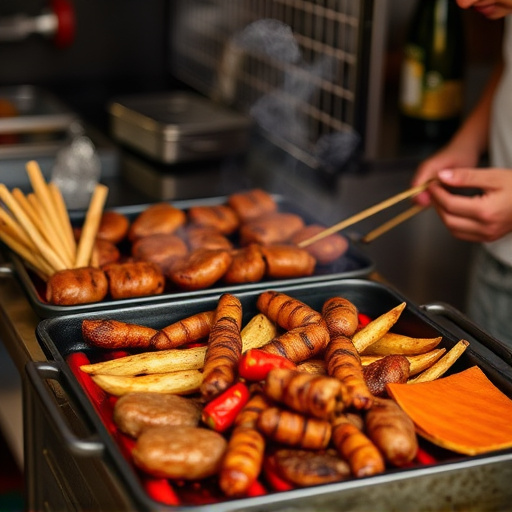Creating the perfect BBQ beef jerky starts with selecting lean, marbled cuts like top round or flank steak (1/4-inch thick). Season with a balanced rub of brown sugar, salt, pepper, garlic & onion powder, and cayenne. Bake at 275°F for 2-3 hours until internal temp reaches 160°F, flipping halfway. Store airtight for up to 2 weeks or freeze longer; enjoy!
Looking for a delicious, homemade BBQ beef jerky recipe? This easy oven method transforms your favorite cut of beef into crispy, flavorful jerky without the need for a smoker. We’ll guide you through selecting the right cut, seasoning with a simple and savory BBQ rub, preparing your oven, and cooking step-by-step to perfection. Learn how to test for doneness and store your homemade BBQ beef jerky like a pro.
- Selecting the Right Cut of Beef for Jerky
- Seasoning the Beef: A Simple BBQ Rub Recipe
- Preparing the Oven: Temperature and Time Considerations
- The Cooking Process: Step-by-Step Guide
- Testing for Doneness: Ensuring Perfect Jerky Every Time
- Storing Your Homemade BBQ Beef Jerky
Selecting the Right Cut of Beef for Jerky
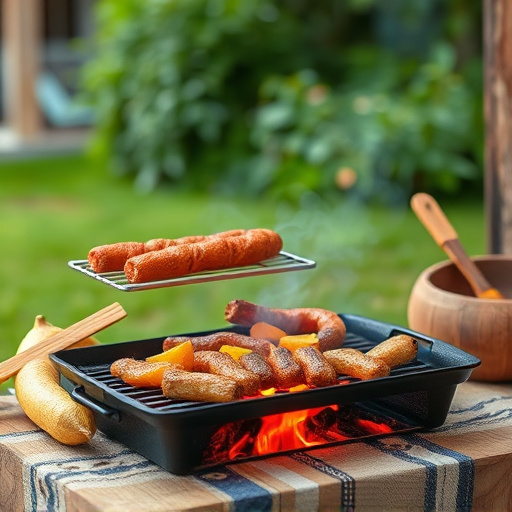
When crafting your perfect BBQ beef jerky recipe, choosing the right cut of meat is key to achieving that tender, flavorful result. Opt for a lean but slightly marbled cut, such as top round steak or flank steak. These cuts provide enough fat to keep the meat moist during the drying process, preventing it from becoming brittle. Avoid excessively fatty cuts, as they can become too chewy after drying and may not crisp up nicely in the oven.
The ideal cut should be about 1/4-inch thick, allowing for even air circulation and ensuring that your jerky doesn’t take on a rough texture. This thickness also facilitates even seasoning penetration, resulting in a flavor-packed BBQ beef jerky recipe that’s sure to satisfy your cravings.
Seasoning the Beef: A Simple BBQ Rub Recipe
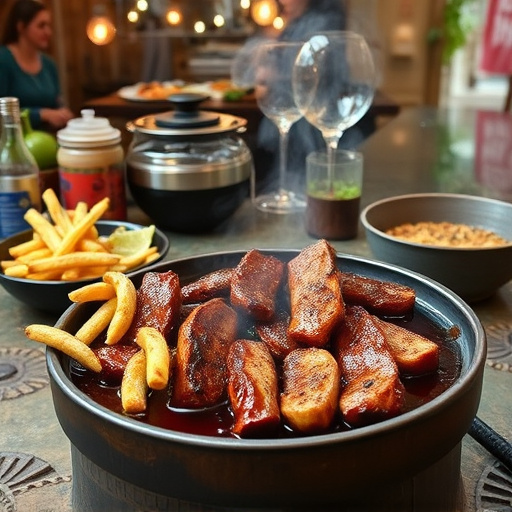
To get started on your easy oven method for making BBQ beef jerky, the first step is seasoning the beef. A simple BBQ rub recipe can transform your jerky from ordinary to exceptional. Combine 2 tablespoons of brown sugar, 1 tablespoon each of coarse salt and black pepper, 1 teaspoon of garlic powder, 1 teaspoon of onion powder, and a pinch of cayenne pepper in a small bowl. This well-balanced mix offers a sweet and savory flavor profile that complements the smoky taste of BBQ jerky perfectly.
Apply the seasoning liberally to your raw beef slices, ensuring every piece is coated evenly. Let the meat sit for at least 30 minutes to allow the flavors to penetrate, or even up to 2 hours in the refrigerator for maximum infusion. This simple step is key to creating a mouthwatering BBQ beef jerky recipe that will have you craving more.
Preparing the Oven: Temperature and Time Considerations
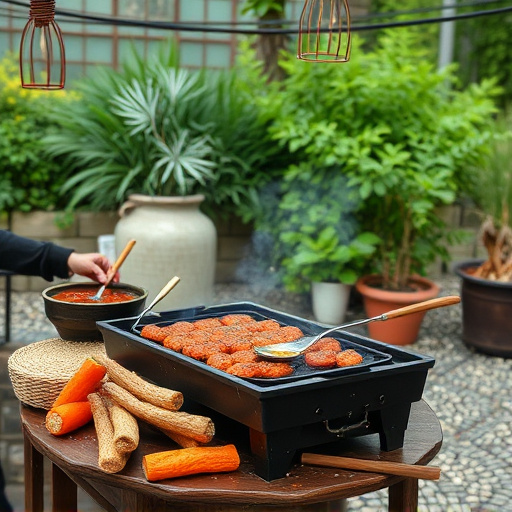
When preparing your BBQ beef jerky using the oven method, getting the temperature and timing right is crucial for achieving that perfect, chewy texture. Preheat your oven to 275°F (135°C), which is the ideal cooking temperature for this technique. This moderate heat allows for slow, even drying without overcooking the meat and ensuring a delicious, tender jerky.
The time required will vary depending on the thickness of your beef slices and your desired level of doneness. As a general guideline, plan for approximately 2-3 hours. Thicker cuts may take longer, while thinner slices will dry faster. Regularly check the meat during the process, using a meat thermometer to ensure it reaches an internal temperature of about 160°F (71°C) before moving on to the next stage, ensuring safety and maximum flavor in your BBQ beef jerky recipe.
The Cooking Process: Step-by-Step Guide
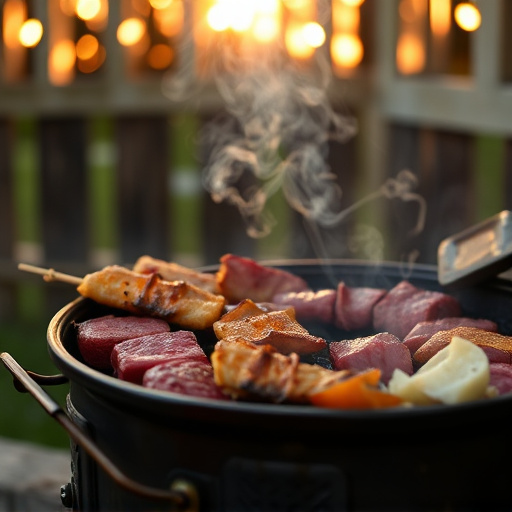
The cooking process for this BBQ beef jerky recipe is straightforward and easy, allowing anyone to become a jerky master in no time. First, preheat your oven to 275°F (135°C). Line a baking sheet with parchment paper and place your thinly sliced beef on top, ensuring the slices don’t overlap. Brush both sides of the meat generously with your favorite BBQ sauce, coating it evenly. This step is crucial for that mouthwatering caramelized glaze.
Once the oven is up to temperature, pop the tray in and bake for approximately 2-3 hours, or until the meat is tender and easily pulls apart with a fork. Remember to flip the slices halfway through cooking to ensure even drying and browning. After the jerky is cooked, let it cool completely before slicing against the grain into thin strips. Store your homemade BBQ beef jerky in an airtight container for up to 2 weeks or freeze for longer shelf life.
Testing for Doneness: Ensuring Perfect Jerky Every Time
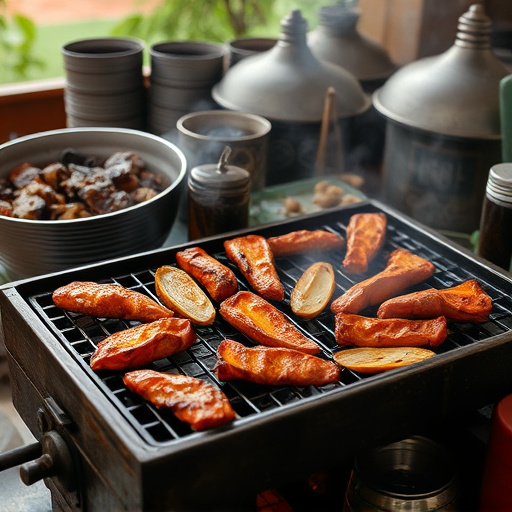
To ensure perfect BBQ beef jerky every time, testing for doneness is crucial. The ideal jerky should be tender and flavorful, with a satisfying crunch. One simple way to check if your jerky is ready is by using a meat thermometer. Insert the thermometer into the thickest part of the jerky slices—they should read around 160°F (71°C). This internal temperature ensures that the beef is fully cooked and safe to consume while still maintaining its desirable texture and taste.
Additionally, gently bend or twist a jerky strip to check for tenderness. It should be pliable and easily break apart without being chewy or tough. If your jerky is still too flexible or doesn’t readily separate into strips, it may need more time in the oven. Following this method allows you to create a delicious BBQ beef jerky recipe that meets the perfect standards of doneness, ensuring each bite is as satisfying as intended.
Storing Your Homemade BBQ Beef Jerky
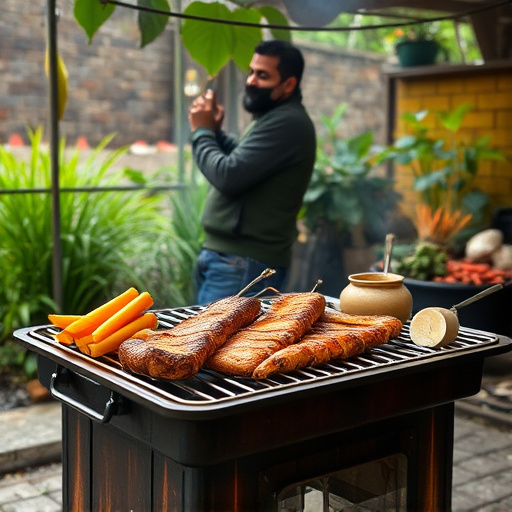
Once your homemade BBQ beef jerky is fully dried and ready, it’s essential to store it properly to maintain its quality and flavor. You can keep your jerky fresh for up to 2 weeks when stored correctly. The best way to preserve this delicious treat is by sealing it in airtight containers or vacuum-sealing bags. This prevents moisture from entering and keeps the meat crisp and flavorful.
For long-term storage, consider freezing your BBQ beef jerky. Freezing ensures that the jerky remains safe for consumption for several months. When ready to enjoy, simply thaw the desired amount at room temperature, and you have a quick, tasty snack! Remember, when storing jerky, keep it away from direct sunlight and heat sources to maintain its texture and taste.
